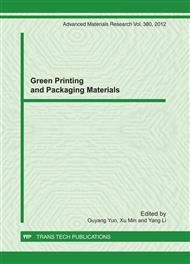p.311
p.316
p.320
p.326
p.331
p.335
p.339
p.344
p.348
The Electroluminescent Devices Based on Benzoxazinone as Strong Fluorescent Material
Abstract:
The yellow-green fluorescent material 2-[2-(p-toluenesulphonylamino)phenyl]-4H-3,1- benzoxazin-4-one (TSPAPB) was synthesized by anthranilic acid and p-toluenesulphonyl chloride. Strong photoluminescent peaks were nearly at 530 nm. The fluorescence lifetime of solid powder was measured to be 6.47 ns by transient fluorescence spectrometer. HOMO and LUMO energy levels were calculated -4.92 and -1.61 eV. The multilayer yellow-green organic light-emitting devices (OLED) ITO/NPB/TSPAPB/BCP/TPBi or Alq3/LiF/Al were fabricated. Device A and B exhibited emissions at 576 nm with current efficiencies (CE) of 1.09 and 0.86 cd/A. The yellow-green electroluminescent peaks of Device C and D were at ca. 588 nm with current efficiencies of 0.94 and 0.68 cd/A, respectively. The characteristics of devices demonstrated that TSPAPB was a yellow-green emitter suitable for OLEDs.
Info:
Periodical:
Pages:
339-343
Citation:
Online since:
November 2011
Authors:
Keywords:
Price:
Сopyright:
© 2012 Trans Tech Publications Ltd. All Rights Reserved
Share:
Citation:


